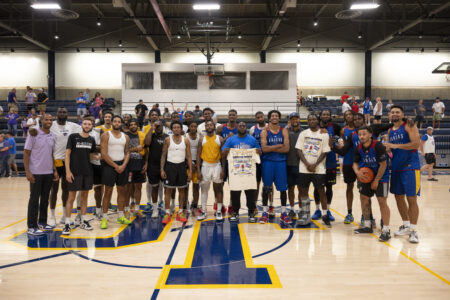Column: KU’s three-point shooting on upward arc

Thanks to the likes of, from left, Brannen Green (13 three-pointers), Wayne Selden Jr. (13), Frank Mason (12) and Sviatoslav Mykhailiuk (11), Kansas University is hitting 39.5 percent of its treys so far this season.
Philadelphia ? The recent hot shooting of Kansas University’s 9-1 basketball team raises a legitimate question: Might this be a better outside shooting team than any other during the current coach’s 12-year regime?
That answer won’t come until March, or if all falls into place, April. But the Jayhawks do seem to be trending in the right direction.
In the past three games, against Georgetown, Utah and Lafayette, Kansas has made 28 of 51 (.549) three-pointers, bringing the season long-range percentage to .395, including .443 in the past seven games.
Just two squads since Roy Williams left have finished a season with a higher three-point percentage than the one Kansas brings into Temple tonight, and last season’s wasn’t one of them. Its .340 three-point shooting percentage ranks 11th of the 12, ahead of only 2003-04 (.335). The Jayhawks of Andrew Wiggins and Joel Embiid ranked last among post-Roy teams with 5.4 threes a game.
The 2009-10 squad, with Sherron Collins, Xavier Henry and Tyrel Reed lighting it up from the perimeter, shot .404 from three and made a regime-best 7.27 threes a game.
The 2007-08 national-championship squad, which had Brandon Rush, Mario Chalmers and Collins keeping defenses honest, shot .397 from long distance.
The team like the one for which Henry played — two guys named Henry, actually; brother C.J. shot .523 from three and had looked as if he had a miserable time doing it — is the gold standard in terms of both accuracy rate and reliance on the three. Led by Collins with 70 three-pointers and Xavier Henry with 69, the Jayhawks averaged 7.27 made threes a game, tops during this 12-year block. So far this year, the team has made 6.2 threes a game.
Should this year’s team shoot 41 percent the rest of the way — certainly a reasonable expectation — it would vault into first place. It already is on pace to do something that none of its 11 predecessors did. Four players average at least one three-pointer a game, and since three of the four are always on the floor together, except in blowouts, Kansas can spread the floor in a rare way.
Brannen Greene and Wayne Selden have made 13 threes, Frank Mason 12, Sviatoslav Mykhailiuk 11. Mason has been the most accurate of the four with a .522 percentage, followed by Greene (.464), Selden (.371) and Mykhailiuk (.344).
When Svi opened the season making just four of 18 threes, teammates warned it wouldn’t be long before the 17-year-old Ukrainian prodigy would knock down shots from long distance. They were right. He has made seven of 14 threes in the past five games.
The same ones delivering optimistic forecasts for Svi’s shooting have done the same of late regarding Selden’s long-range touch. He too is trending in the right direction, making eight of 16 in the last four games.
Now that freshman Kelly Oubre has joined the rotation, that also bodes well for KU’s ability to spread defenses paranoid about the Jayhawks’ ability to score three points at a time.
A look at KU’s free-throw percentage (.746, tops in the current regime) hints at the depth of soft touches on the roster.
A team with a wide array of shooters opens up teams options. It forces defenses to spread out, which opens driving lanes, and Kansas has no shortage of slashers, also. So don’t lose too much sleep over KU’s lack of post presence through whom KU’s typical offense runs. Sports is all about making adjustments, and the depth of shooters on this roster creates exciting possibilities.







